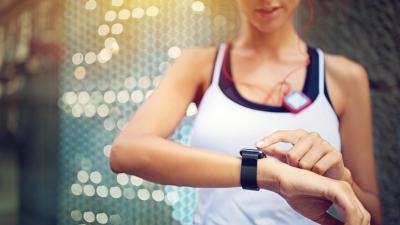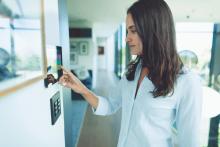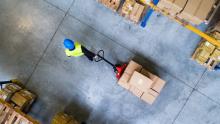- Support portal
- Evaluation Kits and partner products
u-blox Support
- Product documentation
Documentation
- Investor relations
Investor relations
Insights
|
18 Feb 2021
Ten ways e-health and wearable tech can support our mental and physical wellbeing
Technology is enabling always-available healthcare.

A version of this article appeared in our latest u‑blox magazine on eHealth. Download your own copy of the magazine today!
As you read this article, chances are you’ve already experienced digital healthcare in some form. This could be a wearable fitness band to count the number of steps you walk in a day, monitor your heart rate, or keep tabs on how well you’re sleeping. It might be apps on your smartphone that you use to track caffeine or calorie consumption, or your menstrual cycle. Or you may have sent pictures or video to your doctor or medical insurer, ahead of a face-to-face or telephone appointment. All of these are examples of a major digital revolution in healthcare, which looks set to continue apace.
Imagine a world where people are proactively alerted to potential health problems before they cause significant harm, as opposed to reactively reaching out to a doctor once more serious symptoms show, as is often the case today. Portable and wearable sensors are making this possible. And as more of the applications they’re enabling secure formal medical approval, connected technology is moving beyond ‘gadget’ status, to become an increasingly important part of the healthcare space.
Below, we outline 10 examples of how tech is being used to support our physical and mental wellbeing.
1. Detecting and managing neurodegenerative diseases
Alzheimer’s, Parkinson’s, Huntington’s and other neurodegenerative diseases are becoming increasingly prevalent, partly as a result of ageing populations. While there isn’t a cure at the moment, early detection can help those with these conditions to understand and manage them more effectively.
Researchers are working on a variety of techniques to create a ‘digital phenotype’ of these illnesses, using wearable technology to monitor indicators such as lower heart rate variability and the slowing of the gait. It’s hoped this could help support early detection.
2. Responding to falls
Falling is the second-most-common cause of unintentional injury death, according to the World Health Organization. Around 646,000 fatal falls happen every year, mostly among the elderly. In addition, many more people will suffer non-fatal falls that have long-term implications on their health and wellbeing.
Falling is also a danger in certain workplaces, especially where individuals work alone in remote places. If these people have an accident, it may be hours or even days before they’re found.
Happily, technology can help. Wearable devices capable of sensing both falls and inactivity, and then wirelessly sending out distress signals, can be a lifesaver. Options available include specialist equipment, or consumer-oriented wearables, such as Apple Watch.
3. Supporting improved mental health
People suffering with mental health problems can already use their smartphones to access chatbots set up to provide cognitive behavioral therapy. Woebot is an example of what future mental health support could look like, as smart devices, artificial intelligence, counseling, and psychiatry are brought together in intelligent and innovative ways. The app has already been shown to be effective in reducing depression and anxiety.
Elsewhere, AI-driven bots such as Mitsuku can be used to help combat loneliness, which is another major problem, especially among older people.
As demand for mental health support continues to outstrip supply, or for people who feel uncomfortable seeking help due to the stigma or cost associated with it, technological solutions such as these could play an important role in ensuring everyone has access to the support they need.
4. Monitoring the air we breathe
It’s well-understood that long-term exposure to airborne pollution is bad for us. The challenge is knowing when we’re subjecting ourselves to it, given most pollutants are invisible, and some also odorless. Here again, there’s a technology solution, in the form of low-cost sensors that detect levels of fine particulate matter and volatile organic compounds. These can be incorporated into portable devices, such as the Atmotube or Flow, which alert the user, via their smartphone, when thresholds are exceeded. Devices such as these can also collate data to create real-time, crowdsourced maps of air pollution levels, to benefit the wider community.
5. Detecting allergens in our food
In the United States alone, food allergy reactions result in someone going to the emergency room at a hospital every three minutes, according to foodallergy.org. Moreover, the proportion of the population affected by food allergies continues to grow.
The good news is that thanks to the good understanding that now exists of most allergenic compounds, it’s becoming possible to create portable technology solutions capable of detecting them in food. The Allergy Amulet, due to launch this year, promises to analyze food samples and identify whether any of the eight most common food allergens are present, in around 60 seconds. Results can be displayed on a companion app on the user’s phone.
6. Tackling cardiovascular disease
Cardiovascular disease is the biggest global cause of death, according to the World Health Organization. It’s therefore unsurprising we’re seeing an increasing number of technology solutions seeking to tackle these diseases and their causes.
For example, high blood pressure can be a precursor to serious cardiovascular diseases, including cerebrovascular disease and coronary heart disease. However, because high blood pressure generally has no obvious symptoms, it’s often referred to as the ‘silent killer.’ Conventional cuff-style blood pressure monitors that people can use at home have been available for some time, but more convenient solutions to monitor for hypertension are now emerging, such as Aktiia’s bracelet, which enables the wearer to track their blood pressure 24x7.
Elsewhere, electrocardiograms (ECGs) are an important means of detecting possible heart problems. In 2018, the Apple Watch became the first consumer-grade wearable to secure United States Food and Drug Administration (FDA) approval for its ECG monitoring capabilities. Other options include AliveCor’s KardiaMobile, a compact portable device that connects to the user’s smartphone to provide a medical-grade ECG, capable of detecting the three main types of heart rhythm problem, wherever the user happens to be.
7. Helping us live with diabetes
Digital technologies can already make life easier for those living with diabetes. Wearable blood glucose meters can monitor levels round-the-clock, sending the data to a nearby connected device, and then onwards to the cloud. Wearers can opt to receive alerts when they need sugar or insulin, or have care providers or loved ones notified when certain thresholds are exceeded. The loop can then be closed with the use of a connected insulin pen, which dispenses exactly the right amount of the hormone needed to stabilize levels of blood glucose.
By simplifying treatment of the condition in ways such as these, technology is already having a significant impact on people’s lives, even enabling children born with type 1 diabetes to manage it themselves, supervised, from a young age.
8. Analyzing our sleep
It’s now widely appreciated among medical professionals, and the broader public, that sleep is vital for our wellbeing. Too little sleep has been linked to increased incidence of a variety of conditions, including diabetes, neurodegenerative and cardiovascular diseases, cognitive decline, weight gain, compromised immune function, and even cancer. Sleep deprivation can also lead to lost productivity and accidents, with all the associated costs for individuals, society, and the economy.
The proliferation of smart sleep sensors linked to smartphone apps and machine learning algorithms is revolutionizing researchers’ understanding of this crucial aspect of our lives. It’s subsequently helping drive development of tools to help insomnia-sufferers, and to diagnose and treat other issues related to sleep.
9. Protecting against the risks of stress and fatigue
Fatigue and stress can affect our ability to carry out a variety of tasks. Whether you’re a doctor performing surgery, a machinery operator on a construction site, or simply an individual driving a car, a fatigue- or stress-induced mistake can have serious or even fatal consequences.
The smart glasses from Ellcie are an example of technology designed to guard against these risks. Ellcie’s eyewear seeks to prevent road accidents by monitoring drivers for signs of drowsiness. This includes assessing their rate of blinking, yawning, and whether their heads drop. If drowsiness is detected, the glasses sound a warning to the driver. Users in France can also be connected to a helpdesk, for a handsfree conversation aimed at keeping them awake until they can safely stop.
Research is also underway to create wearable skin patches that monitor for signs of stress. These assess variables such as pulse waves, skin temperature, and skin conductance, to calculate levels of stress in real time. This data could then be sent to the wearer’s phone, to suggest they might benefit from having a break.
10. Stimulating our brains
Lastly, imagine if we could get our brains into the perfect state for whatever activity we’re about to do. This is what the NeoRhythm headband from Omnipemf promises. The device emits tuned electromagnetic frequencies to stimulate the brain and is said to be able to help improve sleep, focus, energy, and vitality levels, and even control pain. Omnipemf points to two – admittedly small – double-blind, placebo-controlled studies to back up its claims.
Much more to come
These examples showcase the breadth of opportunity that technology offers when it comes to enhancing both our physical and our mental health. And the exciting thing is that there will be many more in the future, as healthcare innovators continue to leverage new and existing technologies in intelligent ways, all designed to help us live healthier and happier lives.


